
Tribology Online
Scope & Guideline
Bridging academia and industry in tribological advancements.
Introduction
Aims and Scopes
- Friction and Wear Mechanisms:
The journal covers research on the fundamental mechanisms of friction and wear in different materials, including metals, polymers, and composites, highlighting experimental and theoretical investigations. - Lubrication Technologies:
Tribology Online explores various lubrication strategies, including the development of new lubricant formulations and the use of advanced lubrication techniques such as minimum quantity lubrication (MQL) and bio-lubricants. - Surface Engineering and Texturing:
Research on surface modifications, including texturing and coatings, to improve tribological performance is a key focus area, contributing to enhanced durability and efficiency in mechanical systems. - Nanotribology:
The journal addresses the effects of nanoscale phenomena on tribological performance, including studies on nanofluids and nanocomposite materials, which are crucial for advancing lubrication technology. - Tribological Testing and Simulation Methods:
Innovative testing methods and computational modeling techniques are presented to analyze tribological interactions, providing insights into performance predictions and optimization.
Trending and Emerging
- Sustainable and Green Lubricants:
There is an increasing emphasis on the development and evaluation of bio-lubricants and environmentally friendly lubricant additives, driven by global sustainability goals and regulatory pressures. - Advanced Surface Texturing Technologies:
Research on novel surface texturing techniques, including laser texturing and micro/nano-patterning, is trending, with studies focusing on their effects on friction reduction and wear performance. - Machine Learning and AI in Tribology:
The application of machine learning and artificial intelligence for predicting tribological behavior and optimizing lubrication strategies is emerging as a significant trend, showcasing the integration of data science into tribology. - High-Pressure and Extreme Environment Studies:
There is a growing interest in understanding tribological performance under high-pressure and extreme conditions, such as those found in aerospace and automotive applications, reflecting industry needs for reliability. - Interfacial Phenomena and Nanostructures:
Emerging themes include the study of interfacial phenomena at the nanoscale, particularly how molecular interactions influence tribological properties, paving the way for new material designs.
Declining or Waning
- Classical Lubrication Studies:
Traditional studies on bulk lubrication properties and basic viscosity measurements are becoming less frequent, as the focus shifts towards more complex and novel lubrication systems. - Static and Basic Wear Analysis:
Research centered on static wear testing and basic wear mechanisms is waning, giving way to more sophisticated analyses that incorporate dynamic conditions and real-world applications. - Generalized Coating Studies:
While coatings remain important, the journal has seen a decline in generalized studies of coatings without specific applications or novel insights, favoring more targeted investigations into advanced coating technologies. - Basic Friction Measurement Techniques:
Standard friction measurement methodologies are being overshadowed by studies employing advanced techniques and interdisciplinary approaches, leading to a decrease in papers focusing solely on traditional measurement methods.
Similar Journals
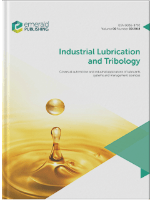
INDUSTRIAL LUBRICATION AND TRIBOLOGY
Enhancing industrial performance through cutting-edge research.INDUSTRIAL LUBRICATION AND TRIBOLOGY, published by EMERALD GROUP PUBLISHING LTD, is a distinguished journal dedicated to the fields of lubrication science and tribology, examining the fundamental aspects and innovative applications that enhance energy efficiency and mechanical performance in industrial settings since its inception in 1948. With an ISSN of 0036-8792, the journal is indexed in recognized databases, and its significant contributions have earned it a respectable Q3 category ranking in the disciplines of Energy, Mechanical Engineering, and Surfaces, Coatings, and Films. Researchers and professionals engaged in these fields will find valuable insights and cutting-edge research that drive innovation and improve the sustainability of industrial practices. While the journal does not currently offer open access options, it continues to be a pivotal platform for disseminating knowledge among scholars and practitioners. Its ongoing relevance in advancing tribological science highlights the critical role of lubrication in enhancing machine longevity and operational efficiency.

Advances in Mechanical Engineering
Unlocking Potential in Mechanical Engineering ExcellenceAdvances in Mechanical Engineering is a premier open-access journal published by SAGE Publications Ltd, dedicated to the advancement of theoretical and applied research in the field of mechanical engineering. With an ISSN of 1687-8132 and an E-ISSN of 1687-8140, this journal has been a vital resource for scholars and practitioners since its inception in 2009. Housed in the United States, it operates under a commitment to ensure free and immediate access to its high-quality content, enhancing collaboration and innovation across the global engineering community. With a noteworthy Q2 ranking in the mechanical engineering category and a solid Scopus rank placing it in the 59th percentile, the journal serves as an influential platform for cutting-edge research, theoretical advancements, and comprehensive reviews. As the field evolves, Advances in Mechanical Engineering continues to cater to the rigorous needs of researchers, professionals, and students, striving to transform knowledge into tangible engineering solutions. This journal's commitment to excellence makes it a significant contributor to the mechanical engineering field, encouraging dynamic discussions and implications for the future.
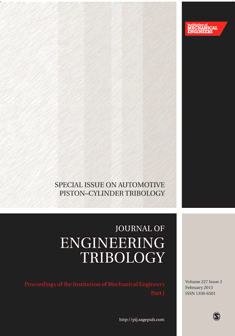
PROCEEDINGS OF THE INSTITUTION OF MECHANICAL ENGINEERS PART J-JOURNAL OF ENGINEERING TRIBOLOGY
Fostering collaboration in the pursuit of tribological breakthroughs.PROCEEDINGS OF THE INSTITUTION OF MECHANICAL ENGINEERS PART J: JOURNAL OF ENGINEERING TRIBOLOGY is a premier scholarly publication dedicated to the intricate field of tribology, which encompasses the study of friction, wear, and lubrication in mechanical systems. Published by SAGE Publications Ltd, this journal aims to advance the scientific understanding and application of tribological principles across various industries, particularly in mechanical engineering. With an impressive impact factor and classified in the Q2 and Q3 quartiles in its respective categories, it provides a vital platform for disseminating innovative research and technical advancements. The journal spans over a rich timeline from 1994 to 2024, signifying its longstanding contribution to the academic community. It invites original research articles, comprehensive reviews, and insightful case studies that push the boundaries of existing knowledge and foster collaborative efforts among researchers, professionals, and students in the field. For those engaged in mechanical engineering and materials science, the journal offers unparalleled access to cutting-edge research that can inform and enhance practical applications in the industry.
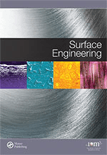
SURFACE ENGINEERING
Innovating at the Intersection of Science and EngineeringSURFACE ENGINEERING, published by SAGE Publications Inc, is a premier international journal dedicated to the advancement of knowledge in the fields of material surface science and engineering. With an ISSN of 0267-0844 and E-ISSN 1743-2944, this esteemed journal has been a critical resource since its inception in 1985, and continues to thrive through 2024. Recognized for its impactful contributions, SURFACE ENGINEERING achieves notable rankings in several categories including Q1 in Conservation and Q2 in key areas such as Condensed Matter Physics and Materials Chemistry. The journal serves a diverse audience of researchers, professionals, and students, providing them with insightful research articles, reviews, and technological developments that drive innovation in surface coatings, materials chemistry, and related disciplines. Although the journal follows a traditional subscription model, it remains an essential platform for disseminating crucial findings and fostering collaborations within the scientific community.

Tribology International
Pioneering Research in Friction, Wear, and Lubrication.Tribology International, published by ELSEVIER SCI LTD, stands as a premier journal in the fields of tribology, mechanical engineering, and material science. With an impressive impact factor and ranking in the Q1 category across multiple disciplines such as Mechanical Engineering and Surfaces, Coatings and Films, this journal serves as a critical resource for researchers, professionals, and students looking to advance their knowledge and application of tribological principles. Established in 1972, Tribology International explores a wide array of topics, including friction, wear, and lubrication, making it indispensable for those dedicated to innovation in engineering and materials sciences. With its rigorous peer-review process and high visibility within the academic community, Tribology International is pivotal in disseminating influential research, fostering new ideas, and shaping the future of tribological research.

Advances in Tribology
Exploring the Frontiers of Friction and WearAdvances in Tribology is a premier open access journal published by HINDAWI LTD, focused on the rapidly evolving fields of tribology, mechanical engineering, and materials science. Since its inception in 2008, the journal has provided a crucial platform for researchers, professionals, and students to disseminate knowledge and advancements in the understanding of friction, wear, and lubrication phenomena. With an impact factor reflective of its significance, Advances in Tribology is ranked in the Q3 category for both Mechanical Engineering and Surfaces, Coatings, and Films as of 2023, situating it among the prominent journals in its field. The journal's commitment to high-quality research is evident in its rigorous peer-review process and its dedication to fostering open access, allowing for widespread dissemination of impactful research. Published in Egypt with global reach, this journal aims to bridge the knowledge gap in tribological applications and innovations, serving as a key resource for those engaged in the study and application of surface interactions.
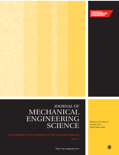
PROCEEDINGS OF THE INSTITUTION OF MECHANICAL ENGINEERS PART C-JOURNAL OF MECHANICAL ENGINEERING SCIENCE
Fostering collaboration and innovation in engineering disciplines.PROCEEDINGS OF THE INSTITUTION OF MECHANICAL ENGINEERS PART C - JOURNAL OF MECHANICAL ENGINEERING SCIENCE, published by SAGE Publications Ltd, stands as a pivotal resource in the field of mechanical engineering, encompassing a wide array of topics from advanced materials to fluid dynamics and system design. With an impact factor reflective of its esteemed reputation, as indicated by its Q2 ranking in the Mechanical Engineering category, this journal serves as a vital forum for researchers, practitioners, and students alike. The journal boasts a rich history, converging research from 1983 to 2024, showcasing innovations and advancements that shape the mechanical engineering landscape. Although it is not an open-access publication, the insights and studies published herein provide invaluable contributions to the engineering community, fostering knowledge exchange and collaborative advancements. Researchers seeking a platform for their pioneering work will find Part C an ideal venue to disseminate their findings and engage with peers in this dynamic field.
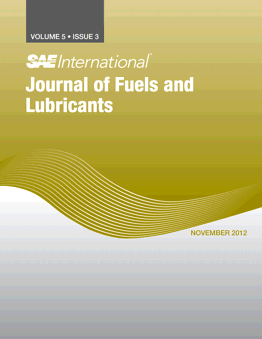
SAE International Journal of Fuels and Lubricants
Pioneering Research for a Greener TomorrowWelcome to the SAE International Journal of Fuels and Lubricants, a leading peer-reviewed publication dedicated to advancing knowledge in the crucial fields of fuel technology and lubrication science. Published by SAE International, this journal serves as a vital resource for researchers, industry professionals, and students engaged in the study and application of innovative fuels and lubricants. With an impact factor indicative of its importance, the journal is ranked in the Q3 category for both Fuel Technology and Pollution, highlighting its critical role in addressing global energy and environmental challenges. Covering a range of topics from fundamental research to practical applications, the journal not only contributes to academic discourse but also serves to inform industry practices. Our publication spans the converged years from 2009 to 2024, reflecting a commitment to continuous scholarly contribution. While currently operating under a traditional access model, the journal aims to foster an inclusive environment for discourse in the rapidly evolving fields of energy and environmental science.
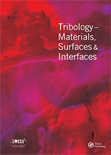
Tribology-Materials Surfaces & Interfaces
Transforming tribological insights into practical applications.Tribology-Materials Surfaces & Interfaces is a leading journal dedicated to advancing the field of tribology, leveraging insights into materials, surfaces, and interface interactions. Published by SAGE Publications Inc in the United Kingdom, this journal plays a pivotal role in disseminating high-quality research, providing a platform for both foundational and applied studies in mechanical engineering and materials science. With an impact factor reflecting its significance, ranking in the third quartile for both Materials Science and Mechanical Engineering, it caters to a diverse audience including researchers, industry professionals, and students. Although it currently does not offer open access, the journal endeavors to periodically review and publish innovative studies that enhance understanding of tribological phenomena, thereby contributing to the development of advanced materials and engineering solutions. Since its inception in 2007, Tribology-Materials Surfaces & Interfaces has consistently presented cutting-edge findings, thereby cementing its position as an essential resource for anyone engaging in tribological research.

Frontiers of Mechanical Engineering
Innovating Today for a Sustainable TomorrowFrontiers of Mechanical Engineering is a premier journal dedicated to advancing the field of mechanical engineering, published by HIGHER EDUCATION PRESS. Located in Beijing, China, this esteemed journal has been a vital platform for innovative research since its establishment in 2011 and continues to contribute significantly to the scientific community with its convergence of studies extending through 2024. With an impressive Q1 ranking in mechanical engineering and a strong placement in the Scopus rankings (#108 out of 672, 84th percentile), the journal showcases high-impact articles that drive forward the knowledge frontier in areas such as thermodynamics, fluid mechanics, and material science. Although it operates on an open-access model, Frontiers of Mechanical Engineering is committed to making significant research universally accessible, ensuring that findings from esteemed researchers reach academic and industrial audiences alike. This journal not only plays a crucial role in disseminating cutting-edge mechanical engineering research but also fosters collaboration between academia and industry experts striving towards innovation and excellence in engineering practices.